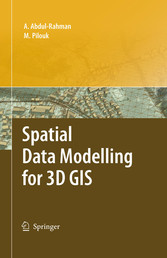Search and Find
Service
Preface
5
Contents
6
Chapter 1 INTRODUCTION
11
1.1 Why does 3D GIS Matter?
11
1.2 The Need for 3D GIS
13
1.3 The Need for 3D Spatial Data Modelling
17
1.4 Problems Associated with Spatial Modelling for 3D GIS
19
1.5 Previous Work
20
1.6 Background to the 3D GIS Problem
23
Chapter 2 AN OVERVIEW OF 3D GIS DEVELOPMENT
24
2.1 GIS Functions
24
2.2 3D GIS
25
2.3 Recent Progress Made on 3D GIS
26
2.4 Commercially Available Systems and 3D GIS
27
2.5 Why is 3D GIS Difficult to Realise?
31
2.6 Discussion
32
Chapter 3 2D AND 3D SPATIAL DATA REPRESENTATIONS
33
3.1 Introduction
33
3.2 Classes of Object Representations
34
3.3 GIS Applicability of the Representations
45
3.4 The Selection Criteria
46
3.5 Vector and Raster Representation
49
3.6 Summary
50
Chapter 4 THE FUNDAMENTALS OF GEO- SPATIAL MODELLING
51
4.1 Spatial Data
52
4.2 Spatial Data Modelling
52
4.3 Models and Their Importance for Geoinformation
53
4.4 Components of Geo-spatial Model
55
4.5 Phases in Geo-spatial Modelling
56
4.6 Conceptual Design of a Geo-spatial Model
58
4.7 Logical Design of Geo-spatial Model
86
4.8 Summary
93
Chapter 5 THE CONCEPTUAL DESIGN
94
5.1 TIN-based (2.5D) Data Model
94
5.2 Properties of the TIN-based Data Model
97
5.3 TEN-based Data Model
101
5.4 Generalized n-dimensional Integrated Data Model
104
5.5 Single-theme and Multi-theme
108
5.6 Euler’s Characteristics
109
5.7 Discussion
114
Chapter 6 THE LOGICAL DESIGN
116
6.1 Relational Approach
116
6.2 Object-oriented Approach
123
6.3 Discussion
137
Chapter 7 OBJECT-ORIENTATION OF TINs SPATIAL DATA
139
7.1 Introduction
139
7.2 Object-oriented Concepts
139
7.3 Object-oriented TIN Tessellations
142
7.4 Object-oriented TINs Spatial Data Modelling
146
7.5 Object-oriented TIN Spatial Database Development
152
7.6 Object-oriented TIN-based Subsystems for GIS
155
7.7 Summary
156
Chapter 8 THE SUPPORTING ALGORITHMS
159
8.1 Introduction
159
8.2 Distance Transformation
159
8.3 Voronoi Tessellations
164
8.4 Triangulations (TINs)
169
8.5 Visualization
176
8.6 3D Distance Transformation
177
8.7 3D Voronoi Tessellation
182
8.8 Tetrahedron Network (TEN) Generation
187
8.9 Constrained Triangulations
189
8.10 Contouring Algorithm
196
8.11 Algorithms for Irregular Network Formation
202
8.11 Summary
210
Chapter 9 APPLICATIONS OF THE MODEL
212
9.1 Integration of Terrain Relief and Terrain Features
212
9.2 Creating an Integrated Database
214
9.3 A Spatial Query Example
217
9.4 Integrating with 3D Features
219
9.5 Integrating with Geo-scientific Data
224
9.6 Spatial Operators
226
9.7 Graphic Visualization
228
9.8 Virtual Reality
235
9.9 Discussion
235
Chapter 10 THE WEB AND 3D GIS
237
10.1 Introduction
237
10.2 Web 3D GIS
238
10.3 Management of 3D Spatial Data
242
10.4 GUI for 3D Visualization and Editing on the Web
244
10.5 Current and Possible Approaches in Urban Planning
252
10.6 Realized Browser-based Solutions
253
10.7 Stand-alone Solutions/Toolkits/Front-ends
258
10.8 Summary
259
Chapter 11 CONCLUSION AND FURTHER OUTLOOK
260
11.1 Summary
260
11.2 Further Research
267
References and Bibliography
270
Index
289
All prices incl. VAT












